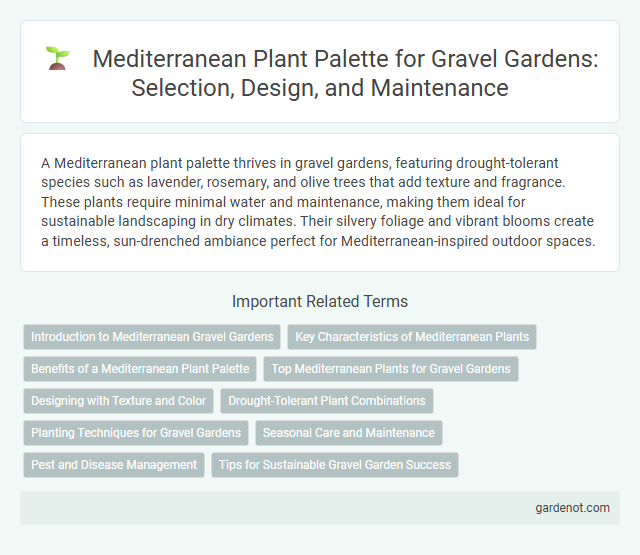A Mediterranean plant palette thrives in gravel gardens, featuring drought-tolerant species such as lavender, rosemary, and olive trees that add texture and fragrance. These plants require minimal water and maintenance, making them ideal for sustainable landscaping in dry climates. Their silvery foliage and vibrant blooms create a timeless, sun-drenched ambiance perfect for Mediterranean-inspired outdoor spaces.
Introduction to Mediterranean Gravel Gardens
Mediterranean gravel gardens utilize drought-tolerant plants such as lavender, rosemary, and oleander, thriving in well-drained, rocky soils with minimal water. These gardens combine textured gravel surfaces with aromatic herbs and evergreen shrubs, creating low-maintenance landscapes ideal for hot, dry climates. The Mediterranean plant palette enhances soil erosion control while supporting biodiversity and attracting pollinators like bees and butterflies.
Key Characteristics of Mediterranean Plants
Mediterranean plants thrive in gravel gardens due to their drought-tolerant nature, silvery or gray-green foliage, and aromatic qualities, which enhance sensory appeal. These plants typically exhibit deep root systems and waxy leaf coatings that minimize water loss and withstand intense sunlight. Common species include lavender, rosemary, and sage, all adapted to nutrient-poor, well-draining soils characteristic of gravel garden environments.
Benefits of a Mediterranean Plant Palette
A Mediterranean plant palette enhances gravel gardens by offering drought-tolerant species such as lavender, rosemary, and olive trees that thrive in well-drained, low-water conditions. These plants improve soil health, reduce maintenance requirements, and attract pollinators like bees and butterflies. Their resilient nature and aromatic foliage contribute to sustainable landscaping, conserving water while providing year-round visual interest.
Top Mediterranean Plants for Gravel Gardens
Top Mediterranean plants for gravel gardens include lavender, rosemary, and Santolina, which thrive in well-drained, rocky soils and withstand drought conditions. These plants offer aromatic foliage and vibrant blooms, enhancing the garden's texture while requiring minimal maintenance. Incorporating drought-tolerant Mediterranean species such as cistus and thyme further boosts resilience and aesthetic appeal in gravel garden designs.
Designing with Texture and Color
Mediterranean plant palettes excel in gravel gardens by combining drought-tolerant species like lavender, rosemary, and olive trees, which create vibrant textures and rich, sun-drenched colors. The interplay of silvery foliage, deep greens, and bursts of lavender or yellow flowers enhances visual interest while thriving in well-drained, nutrient-poor soils. Using contrasting leaf shapes and seasonal blooms maximizes sensory appeal and supports sustainable, low-maintenance landscape design.
Drought-Tolerant Plant Combinations
Mediterranean plant palettes excel in gravel gardens by incorporating drought-tolerant species like lavender, rosemary, and Santolina, which thrive under minimal water conditions. Combining evergreen shrubs such as olive trees with aromatic herbs like thyme enhances soil retention and promotes biodiversity. These resilient plants reduce irrigation needs while creating a textured, fragrant landscape ideal for sustainable xeriscaping.
Planting Techniques for Gravel Gardens
Mediterranean plant palettes thrive in gravel gardens by utilizing drought-tolerant species like lavender, rosemary, and olive trees, which reduce water consumption and enhance soil drainage. Strategic planting techniques such as creating microclimates with raised beds and mulching with gravel aid in moisture retention and weed suppression. Proper spacing and layering of low-growing ground covers combined with taller shrubs optimize root zones and sunlight exposure, promoting healthy plant growth in gravel substrates.
Seasonal Care and Maintenance
Mediterranean plants in a gravel garden thrive with regular seasonal pruning to promote healthy growth and flowering. Applying mulch in autumn helps retain moisture and suppress weeds during dry periods. Monitoring soil drainage and adjusting irrigation based on seasonal rainfall ensures these drought-tolerant species remain vibrant year-round.
Pest and Disease Management
Mediterranean plant palettes in gravel gardens, featuring species such as lavender, rosemary, and olive trees, exhibit natural resistance to common pests and diseases due to their drought tolerance and aromatic oils. Effective pest and disease management involves monitoring for specific threats like aphids, powdery mildew, and olive knot, which can impact plant health in dry, well-drained gravel beds. Integrating biological controls, promoting plant diversity, and maintaining proper irrigation practices enhance resilience against infestations and infections in Mediterranean gravel gardens.
Tips for Sustainable Gravel Garden Success
Choose drought-tolerant Mediterranean plants like lavender, rosemary, and santolina for a sustainable gravel garden that thrives with minimal water. Incorporate native species that are well-adapted to local climates to reduce maintenance and promote biodiversity. Use organic mulch beneath gravel to retain soil moisture and suppress weeds, enhancing long-term garden health.
Mediterranean plant palette Infographic

 gardenot.com
gardenot.com